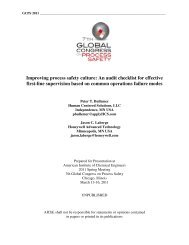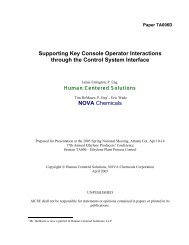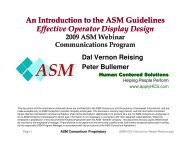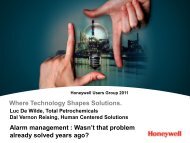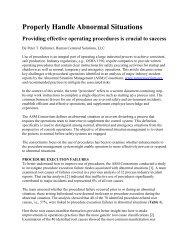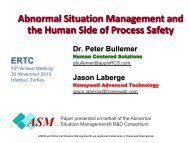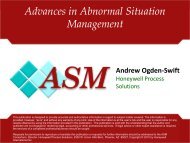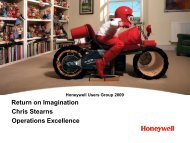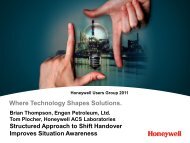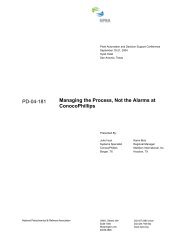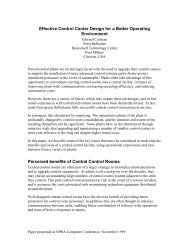The Need for Excellence in Safe Operations to ... - ASM Consortium
The Need for Excellence in Safe Operations to ... - ASM Consortium
The Need for Excellence in Safe Operations to ... - ASM Consortium
You also want an ePaper? Increase the reach of your titles
YUMPU automatically turns print PDFs into web optimized ePapers that Google loves.
<strong>The</strong> <strong>Need</strong> <strong>for</strong> <strong>Excellence</strong> <strong>in</strong> <strong>Safe</strong> <strong>Operations</strong><br />
<strong>to</strong> Manage High Risk Plants<br />
Human Reliability : learn<strong>in</strong>g from Aviation Industry<br />
Herman Van Roost<br />
MarcusEvans 2 nd Annual Health & <strong>Safe</strong>ty Management Convention <strong>in</strong> EMEA Region<br />
Prague, September 14 th and 15 th , 2009
Acknowledgement<br />
Contributions from external sources (publications) :<br />
CCPS<br />
2005 – 2009 Convention papers<br />
Library of handbooks “Guidel<strong>in</strong>es …..”<br />
<strong>ASM</strong> <strong>Consortium</strong><br />
Incl. Honeywell<br />
Air France Flight <strong>Operations</strong><br />
Etienne Lichtenberger, VP Flight <strong>Safe</strong>ty and Quality<br />
ICSI<br />
Senior authors on process safety<br />
Trevor Kletz<br />
Andrew Hopk<strong>in</strong>s<br />
…<br />
MarcusEvans 2 nd Annual Health & <strong>Safe</strong>ty Management Convention <strong>in</strong> EMEA Region<br />
Prague, September 14 th and 15 th , 2009<br />
2
« Total considers safety <strong>in</strong> regard <strong>to</strong><br />
operations, human health, respect <strong>for</strong> the<br />
environment and cus<strong>to</strong>mer satisfaction<br />
as paramount priorities. »<br />
Article 1 of Health, <strong>Safe</strong>ty, Environment, Quality Charter<br />
January 2001<br />
3<br />
MarcusEvans 2 nd Annual Health & <strong>Safe</strong>ty Management Convention <strong>in</strong> EMEA Region<br />
Prague, September 14 th and 15 th , 2009<br />
3
TOTAL : hundreds of high risk <strong>in</strong>stallations worldwide<br />
28 sites<br />
4 term<strong>in</strong>als<br />
168 sites<br />
84 term<strong>in</strong>als<br />
68 sites<br />
25 term<strong>in</strong>als<br />
Chemicals<br />
(75)<br />
UPSTREAM<br />
70<br />
34 sites<br />
11 term<strong>in</strong>als<br />
151 sites<br />
82 term<strong>in</strong>als<br />
5 sites<br />
16 term<strong>in</strong>als<br />
DOWNSTREAM<br />
(309)<br />
450 operated sites,<br />
222 term<strong>in</strong>als,<br />
23 000 km pipel<strong>in</strong>es<br />
MarcusEvans 2 nd Annual Health & <strong>Safe</strong>ty Management Convention <strong>in</strong> EMEA Region<br />
Prague, September 14 th and 15 th , 2009<br />
4
Total his<strong>to</strong>rical safety <strong>in</strong>dica<strong>to</strong>rs : LTIR, TRIR (°)<br />
6<br />
5<br />
Source: Total Hold<strong>in</strong>g <strong>Safe</strong>ty Report (data of month-2)<br />
5,50<br />
August 2009<br />
12-months roll<strong>in</strong>g<br />
4<br />
3,90<br />
LTIR<br />
TRIR<br />
3<br />
2<br />
3,30<br />
2,70<br />
2,40<br />
2,90<br />
2,00<br />
3,20<br />
1,70<br />
2,50<br />
2,40<br />
2,10<br />
1<br />
0<br />
Chemical<br />
Branch<br />
Ref<strong>in</strong><strong>in</strong>g<br />
Ref<strong>in</strong><strong>in</strong>g -<br />
Market<strong>in</strong>g<br />
LTIR 3,30 2,70 2,40 2,00 1,70 0,80 0,60<br />
TRIR 5,50 3,90 2,90 3,20 2,50 2,40 2,10<br />
0,80<br />
TOTAL Gaz & Power Petrochemicals<br />
0,60<br />
Exploration -<br />
Production<br />
(°) LTIR = number of Lost Time Injuries per million work<strong>in</strong>g hours<br />
TRIR = number of Recordable Incidents per million work<strong>in</strong>g hours<br />
MarcusEvans 2 nd Annual Health & <strong>Safe</strong>ty Management Convention <strong>in</strong> EMEA Region<br />
Prague, September 14 th and 15 th , 2009<br />
5
Total Petrochemicals : external position<strong>in</strong>g<br />
MarcusEvans 2 nd Annual Health & <strong>Safe</strong>ty Management Convention <strong>in</strong> EMEA Region<br />
Prague, September 14 th and 15 th , 2009<br />
6
Accident typology<br />
Ground level fall<br />
Stra<strong>in</strong>s<br />
Contact with object or squeeze<br />
Hit by fly<strong>in</strong>g / fall<strong>in</strong>g object<br />
Fall from height<br />
Exposure <strong>to</strong> fire / explosion<br />
Exposure <strong>to</strong> dangerous product<br />
Product related<br />
Contact with mov<strong>in</strong>g mach<strong>in</strong>ery parts<br />
Traffic accident<br />
Fire<br />
Trapped by someth<strong>in</strong>g collaps<strong>in</strong>g or overturn<strong>in</strong>g<br />
Spill<br />
0 2 4 6 8 10 12 14 16 18 20<br />
%<br />
~700 accidents <strong>in</strong> Total Petrochemicals <strong>in</strong> the period 1998 - 2008<br />
MarcusEvans 2 nd Annual Health & <strong>Safe</strong>ty Management Convention <strong>in</strong> EMEA Region<br />
Prague, September 14 th and 15 th , 2009<br />
7
Petrochemical <strong>in</strong>dustry <strong>in</strong> the ’60 – ’80 period<br />
% of 270 crackers <strong>in</strong> operation <strong>in</strong><br />
2003<br />
Steady growth of chemistry and<br />
petrochemistry<br />
« New » type of accidents, not<br />
covered by legislation<br />
Physical phenomena (BLEVE, VCE)<br />
are not well unders<strong>to</strong>od<br />
100<br />
90<br />
80<br />
70<br />
60<br />
50<br />
40<br />
30<br />
20<br />
10<br />
0<br />
Illustration of the growth of the petrochemical <strong>in</strong>dustry:<br />
"Evolution of number of steamcrackers <strong>in</strong> operation"<br />
1950 1955 1960 1965 1970 1975 1980 1985 1990 1995 2000 2003<br />
MarcusEvans 2 nd Annual Health & <strong>Safe</strong>ty Management Convention <strong>in</strong> EMEA Region<br />
Prague, September 14 th and 15 th , 2009<br />
France (1973)<br />
BLEVE road tanker<br />
13 fatalities<br />
37 <strong>in</strong>juries<br />
France (1966)<br />
BLEVE Spheres<br />
18 fatalities<br />
81 <strong>in</strong>juries<br />
Spa<strong>in</strong> (1978)<br />
BLEVE road tanker<br />
216 fatalities<br />
200 <strong>in</strong>juries<br />
Mexico (1984)<br />
BLEVE LPG depot<br />
500 fatalities<br />
7,000 <strong>in</strong>juries<br />
UK (1974)<br />
VCE chemical site<br />
28 fatalities<br />
104 <strong>in</strong>juries<br />
Belgium (1967)<br />
BLEVE road tanker<br />
22 fatalities<br />
47 <strong>in</strong>juries<br />
Netherlands (1975)<br />
VCE steamcracker<br />
14 fatalities<br />
107 <strong>in</strong>juries<br />
Netherlands (1971)<br />
Butadiene explosion<br />
8 fatalities<br />
21 <strong>in</strong>juries<br />
Italy (1977)<br />
VCE steamcracker<br />
3 fatalities<br />
107 <strong>in</strong>juries<br />
Bhopal (1984)<br />
Toxic release<br />
20,000 fatalities<br />
200,000 <strong>in</strong>juries<br />
8
Science, <strong>in</strong>dustry and authorities<br />
have steadily moved <strong>for</strong>ward <strong>to</strong>gether<br />
Dist<strong>in</strong>ction of « Seveso » class <strong>in</strong>stallation<br />
Deep understand<strong>in</strong>g and modell<strong>in</strong>g of explosion<br />
physics and chemistry<br />
VCE : deflagration – de<strong>to</strong>nation – … + <strong>in</strong>fluenc<strong>in</strong>g fac<strong>to</strong>rs<br />
Overpressure damage and resistance of build<strong>in</strong>gs<br />
Quantitative modell<strong>in</strong>g + extensive test<strong>in</strong>g<br />
Risk evaluation techniques and modell<strong>in</strong>g<br />
Risk matrix<br />
QRA<br />
FMEA, Fault Tree, Bow-Tie, …<br />
Technical prevention concepts and norms<br />
LOPA, SIS, …<br />
Asset <strong>in</strong>tegrity<br />
Management of Change<br />
Best Industry Practices<br />
APEX, …<br />
Management systems<br />
ISRS, AIMS, ISO14000, …<br />
MarcusEvans 2 nd Annual Health & <strong>Safe</strong>ty Management Convention <strong>in</strong> EMEA Region<br />
Prague, September 14 th and 15 th , 2009<br />
9
S<strong>in</strong>ce 2000, a new series of spectacular accidents<br />
hit the process <strong>in</strong>dustry ….<br />
<strong>The</strong> accidents happen now <strong>in</strong> an<br />
environment that was thought<br />
« under control » :<br />
- Adapted legislation (Seveso)<br />
- High standard of design<br />
- Well established companies<br />
- Good safety track record (LTI)<br />
Toulouse, 2001<br />
Buncefield, 2005<br />
Skikda, 2004 Texas City, 2005<br />
MarcusEvans 2 nd Annual Health & <strong>Safe</strong>ty Management Convention <strong>in</strong> EMEA Region<br />
Prague, September 14 th and 15 th , 2009<br />
10
Corporate Action :<br />
Process <strong>Safe</strong>ty Management Improvement Plan<br />
Hazards and risks are identified<br />
<strong>Safe</strong>ty management systems are <strong>in</strong> place<br />
Expertise and methods are available<br />
Technical resources are <strong>in</strong> place<br />
Incidents and near-misses are analyzed and<br />
the learn<strong>in</strong>g process is stimulated<br />
…. BUT the ma<strong>in</strong> vulnerability appears <strong>to</strong> be<br />
Human and Organizational Fac<strong>to</strong>rs<br />
11<br />
MarcusEvans 2 nd Annual Health & <strong>Safe</strong>ty Management Convention <strong>in</strong> EMEA Region<br />
Prague, September 14 th and 15 th , 2009<br />
11
Reliability Management perspective :<br />
same observation<br />
DCS<br />
Instrumentation<br />
Utilities<br />
Furnaces<br />
Ma<strong>in</strong>tenance<br />
Rotat<strong>in</strong>g<br />
Electricity<br />
Process<br />
Mechanical Integrity<br />
Lost opportunities repartition 2004-2008<br />
<strong>Operations</strong><br />
Increas<strong>in</strong>g weight<br />
0 5 10 15 20 25 30<br />
%<br />
2008 Average 2004-2008<br />
12<br />
MarcusEvans 2 nd Annual Health & <strong>Safe</strong>ty Management Convention <strong>in</strong> EMEA Region<br />
Prague, September 14 th and 15 th , 2009<br />
12
Competency – complexity gap<br />
Required<br />
competency<br />
Available<br />
competencies<br />
mismatch<br />
Operational<br />
complexity<br />
mismatch<br />
Complexity<br />
MarcusEvans 2 nd Annual Health & <strong>Safe</strong>ty Management Convention <strong>in</strong> EMEA Region<br />
Prague, September 14 th and 15 th , 2009<br />
13
Why the problem gets worse<br />
Required<br />
competency<br />
Push operational<br />
& technical competency<br />
= Tra<strong>in</strong><strong>in</strong>g, hir<strong>in</strong>g level,<br />
retention, spare resources…<br />
Available<br />
competencies<br />
mismatch<br />
Competency leakage<br />
(retirement of experienced,<br />
job hopp<strong>in</strong>g, career moves…)<br />
Operational<br />
complexity<br />
?<br />
Reduce work complexity<br />
= Operational Management<br />
mismatch<br />
Broader tasks<br />
New technology<br />
New constra<strong>in</strong>ts<br />
In<strong>for</strong>mation overflow<br />
Heavy procedures<br />
Complexity<br />
MarcusEvans 2 nd Annual Health & <strong>Safe</strong>ty Management Convention <strong>in</strong> EMEA Region<br />
Prague, September 14 th and 15 th , 2009<br />
14
<strong>Operations</strong> & Ma<strong>in</strong>tenance functions :<br />
KEY ac<strong>to</strong>rs <strong>in</strong> Process <strong>Safe</strong>ty<br />
Unique position : monopoly on field reality<br />
Population exposed <strong>to</strong> accidents<br />
Last l<strong>in</strong>e of defence <strong>for</strong> MOC, eng<strong>in</strong>eer<strong>in</strong>g / construction errors,<br />
technical failures<br />
Centre of the petrochemical profession : need<strong>in</strong>g SUPPORT from all<br />
others<br />
Concentration of observed Human Per<strong>for</strong>mance Error and<br />
Accountability issues<br />
MarcusEvans 2 nd Annual Health & <strong>Safe</strong>ty Management Convention <strong>in</strong> EMEA Region<br />
Prague, September 14 th and 15 th , 2009<br />
15
Human Per<strong>for</strong>mance Error <strong>in</strong> <strong>Operations</strong> and<br />
Ma<strong>in</strong>tenance functions = major risk contribu<strong>to</strong>r<br />
Selection of reported accidents and near misses, 2007 - 2009<br />
2007-065 2008-026 2008-028 2008-059 2008-061<br />
Burns by<br />
caustic<br />
soda dur<strong>in</strong>g<br />
opera<strong>to</strong>r<br />
<strong>in</strong>tervention<br />
at a pump<br />
Worker<br />
spread with<br />
sulphuric<br />
acid<br />
Work<strong>in</strong>g on<br />
a bl<strong>in</strong>d<br />
while<br />
system still<br />
<strong>in</strong> service<br />
Worker<br />
spread with<br />
sulphuric<br />
acid<br />
Ethylene<br />
ship<br />
connected<br />
<strong>to</strong><br />
propylene<br />
load<strong>in</strong>g arm<br />
2008-065 2008-070 2008-072 2009-014 2009-020<br />
Case<br />
study<br />
Isobutane<br />
cloud after<br />
rupure of<br />
nitrogen<br />
hose dur<strong>in</strong>g<br />
startup<br />
Large<br />
benzene<br />
spill <strong>in</strong><br />
pipeway<br />
Hot quench<br />
oil spread<br />
on opera<strong>to</strong>r<br />
after<br />
manometer<br />
removal<br />
Large fuel<br />
oil spill<br />
after<br />
contrac<strong>to</strong>r<br />
opened<br />
purge<br />
Fire dur<strong>in</strong>g<br />
furnace<br />
startup<br />
MarcusEvans 2 nd Annual Health & <strong>Safe</strong>ty Management Convention <strong>in</strong> EMEA Region<br />
Prague, September 14 th and 15 th , 2009<br />
16
Operational Reliability / Process <strong>Safe</strong>ty<br />
Case Study<br />
2008 Near Miss :<br />
Isobutane cloud after rupture of nitrogen hose<br />
dur<strong>in</strong>g startup after Turnaround<br />
MarcusEvans 2 nd Annual Health & <strong>Safe</strong>ty Management Convention <strong>in</strong> EMEA Region<br />
Prague, September 14 th and 15 th , 2009<br />
17
Typical use of flexible hoses <strong>for</strong> N2 (10 bar) purg<strong>in</strong>g,<br />
<strong>to</strong> prepare <strong>for</strong> start-up after « turn-around »<br />
MarcusEvans 2 nd Annual Health & <strong>Safe</strong>ty Management Convention <strong>in</strong> EMEA Region<br />
Prague, September 14 th and 15 th , 2009<br />
18
Sequence of events (1)<br />
Proceed<strong>in</strong>g of startup procedure of polymerization unit E after 3w Turnaround<br />
18/10 Recycle isobutane system : isolation bl<strong>in</strong>ds removed, pressure tested<br />
20/10 Startup log : comment about rema<strong>in</strong><strong>in</strong>g N2 flexible hose connected <strong>to</strong> the<br />
process<br />
23/10 Preparation <strong>for</strong> fill<strong>in</strong>g and startup :<br />
New nitrogen purge<br />
Opera<strong>to</strong>r <strong>to</strong>ur : flexible hoses removed<br />
25/10 (saturday night)<br />
1h56 Isobutane pump started (45 bar)<br />
while a flexible hose was still connected<br />
1h57 Flexible hose bursts ; spill of liquid isoC4 ;<br />
35 gas alarms light up<br />
MarcusEvans 2 nd Annual Health & <strong>Safe</strong>ty Management Convention <strong>in</strong> EMEA Region<br />
Prague, September 14 th and 15 th , 2009<br />
19
Detection by gasdetec<strong>to</strong>rs<br />
30m<br />
Location leak<br />
75-100% LEL<br />
25-50% LEL<br />
10-25% LEL<br />
100m<br />
MarcusEvans 2 nd Annual Health & <strong>Safe</strong>ty Management Convention <strong>in</strong> EMEA Region<br />
Prague, September 14 th and 15 th , 2009<br />
20
Sequence of events (2)<br />
Emergency response by <strong>Operations</strong><br />
1h58 Pump s<strong>to</strong>pped from MCR<br />
2h01-05 : feed <strong>to</strong> reac<strong>to</strong>r s<strong>to</strong>pped and reac<strong>to</strong>r dumped (<strong>to</strong> the flare)<br />
No w<strong>in</strong>d, C4 vapour cloud hang<strong>in</strong>g <strong>in</strong> the plant<br />
2h07 Fire brigade starts dilut<strong>in</strong>g the C4 cloud with spr<strong>in</strong>klers & fire guns<br />
2h24 No more gas alarms<br />
2h36 Formal end of alarm phase<br />
Post-calculation by corporate Process <strong>Safe</strong>ty experts :<br />
Estimated spill 2500 kg i-C4<br />
Calculated vapour cloud of 2000 m3<br />
Potential effect : Vapour Cloud Explosion<br />
700 mbar @ 30m ; 130 mbar @ 100m<br />
MarcusEvans 2 nd Annual Health & <strong>Safe</strong>ty Management Convention <strong>in</strong> EMEA Region<br />
Prague, September 14 th and 15 th , 2009<br />
21
Sequence of events (2)<br />
Emergency response by <strong>Operations</strong><br />
1h58 Pump s<strong>to</strong>pped from MCR<br />
2h01-05 : feed <strong>to</strong> reac<strong>to</strong>r s<strong>to</strong>pped and reac<strong>to</strong>r dumped (<strong>to</strong> the flare)<br />
No w<strong>in</strong>d, C4 vapour cloud hang<strong>in</strong>g <strong>in</strong> the plant<br />
2h07 Fire brigade starts dilut<strong>in</strong>g the C4 cloud with spr<strong>in</strong>klers & fire guns<br />
2h24 No more gas alarms<br />
2h36 Formal end of alarm phase<br />
Post-calculation by corporate Process <strong>Safe</strong>ty experts :<br />
Estimated spill 2500 kg i-C4<br />
Calculated vapour cloud of 2000 m3<br />
Potential effect : Vapour Cloud Explosion<br />
700 mbar @ 30m ; 130 mbar @ 100m<br />
MarcusEvans 2 nd Annual Health & <strong>Safe</strong>ty Management Convention <strong>in</strong> EMEA Region<br />
Prague, September 14 th and 15 th , 2009<br />
22
Physical evidence<br />
Coupl<strong>in</strong>g still on the purge, the<br />
flexible teared apart<br />
<strong>The</strong> purge valve was open (and<br />
closed dur<strong>in</strong>g the emergency<br />
<strong>in</strong>tervention)<br />
MarcusEvans 2 nd Annual Health & <strong>Safe</strong>ty Management Convention <strong>in</strong> EMEA Region<br />
Prague, September 14 th and 15 th , 2009<br />
<strong>The</strong> valve at the other side of the<br />
flexible (N2 collec<strong>to</strong>r) was closed<br />
23
Initial summary of conclusions :<br />
Direct cause :<br />
<br />
N2 flexible hose <strong>in</strong> connection with the process dur<strong>in</strong>g startup<br />
(Exact <strong>in</strong><strong>for</strong>mation about reason and tim<strong>in</strong>g of the last operation of this<br />
flexible could not be provided)<br />
Ma<strong>in</strong> cause = “Human Per<strong>for</strong>mance Error” :<br />
1. Procedure not followed : flexible hoses must be taken away be<strong>for</strong>e startup<br />
2. <strong>The</strong> flexible hose was not seen dur<strong>in</strong>g control be<strong>for</strong>e startup<br />
MarcusEvans 2 nd Annual Health & <strong>Safe</strong>ty Management Convention <strong>in</strong> EMEA Region<br />
Prague, September 14 th and 15 th , 2009<br />
24
Human Per<strong>for</strong>mance Error : now what ?<br />
Sanction ?<br />
Tra<strong>in</strong><strong>in</strong>g ?<br />
Better procedure ?<br />
Tell<strong>in</strong>g people <strong>to</strong> take more care ?<br />
People behaviour program ?<br />
<strong>Safe</strong>ty Culture improvement ?<br />
Comparison : car driver safety<br />
I had <strong>in</strong>itial driv<strong>in</strong>g tra<strong>in</strong><strong>in</strong>g<br />
I know the traffic regulation<br />
I became very experienced on the road<br />
I feel responsible <strong>for</strong> my family<br />
I follow tra<strong>in</strong><strong>in</strong>g on defensive driv<strong>in</strong>g<br />
I am physically and mentally OK<br />
My car is com<strong>for</strong>table + techn. OK<br />
I know the road very well<br />
Which of these would effectively<br />
avoid my human errors ?<br />
Still I make “human errors” !<br />
- many m<strong>in</strong>or<br />
- sometimes “near miss”<br />
- exceptionally an accident<br />
MarcusEvans 2 nd Annual Health & <strong>Safe</strong>ty Management Convention <strong>in</strong> EMEA Region<br />
Prague, September 14 th and 15 th , 2009<br />
25
About Human Per<strong>for</strong>mance Error<br />
Human Error = unavoidable, l<strong>in</strong>ked <strong>to</strong> the specific nature of people !<br />
Required strategy =<br />
- Understand human error<br />
- Reduce error-likel<strong>in</strong>ess<br />
by adapt<strong>in</strong>g work <strong>to</strong> people<br />
- Strengthen the defence<br />
barriers prevent<strong>in</strong>g<br />
evolution <strong>in</strong><strong>to</strong> major<br />
accidents<br />
- Cont<strong>in</strong>uous learn<strong>in</strong>g :<br />
active track<strong>in</strong>g of m<strong>in</strong>or<br />
work errors and near<br />
misses<br />
Cfr. <strong>The</strong> success we booked<br />
with personal safety (LTI) !<br />
Figure from Honeywell & <strong>ASM</strong> <strong>Consortium</strong><br />
MarcusEvans 2 nd Annual Health & <strong>Safe</strong>ty Management Convention <strong>in</strong> EMEA Region<br />
Prague, September 14 th and 15 th , 2009<br />
26
Human Per<strong>for</strong>mance Error <strong>in</strong> Process <strong>Operations</strong> :<br />
Classification accord<strong>in</strong>g <strong>to</strong> CCPS<br />
Opera<strong>to</strong>r perspective :<br />
Allows management <strong>to</strong><br />
understand and <strong>to</strong> def<strong>in</strong>e<br />
remedies <strong>for</strong> help<br />
Active failures<br />
Latent conditions<br />
Slip Mistake Laps Violation<br />
Correct<br />
Intent<br />
but<br />
failure <strong>in</strong><br />
execution<br />
Action as<br />
<strong>in</strong>tended<br />
but<br />
<strong>in</strong>tention<br />
was wrong<br />
Expertise failure<br />
Lack of expertise<br />
Error <strong>in</strong><br />
memory<br />
recall<br />
Intended<br />
action that<br />
deliberately<br />
ignores a<br />
known rule,<br />
restriction or<br />
procedure<br />
Sociotechnical<br />
Based<br />
on team<br />
behaviour<br />
Mgt / org.<br />
failure<br />
E.g. unclear<br />
goal sett<strong>in</strong>g,<br />
poorly def<strong>in</strong>ed<br />
roles and<br />
responsibilities,<br />
allow<strong>in</strong>g<br />
deviance,<br />
…<br />
In comb<strong>in</strong>ation<br />
with active<br />
failure, will<br />
result <strong>in</strong><br />
<strong>in</strong>cident<br />
Includes<br />
management /<br />
organisational<br />
error<br />
MarcusEvans 2 nd Annual Health & <strong>Safe</strong>ty<br />
Shortcut<br />
Management<br />
Necessary<br />
Convention<br />
Optimis<strong>in</strong>g<br />
<strong>in</strong> EMEA Region<br />
Exceptional<br />
Prague, September 14 th and 15 th , 2009<br />
27
<strong>The</strong> Aviation <strong>in</strong>dustry as external benchmark :<br />
they survived by becom<strong>in</strong>g successfull <strong>in</strong> Human Reliability<br />
1) Organisational FUNDAMENTALS were imposed <strong>to</strong> all ac<strong>to</strong>rs<br />
Common but specific <strong>for</strong> the <strong>in</strong>dustry, centralised and audited by a regula<strong>to</strong>ry body<br />
(IATA)<br />
Cover<strong>in</strong>g all <strong>in</strong>dustrial activities<br />
airl<strong>in</strong>es, airports, air traffic control, airplane construction, …<br />
<strong>in</strong>dependant of the type of airplane, technology, use, size, …<br />
Focused on human reliability, by <strong>in</strong>tegrat<strong>in</strong>g the science of “Human Fac<strong>to</strong>rs” (HF)<br />
Respect<strong>in</strong>g these rules has become part of the professionalism and image of<br />
every <strong>in</strong>dividual <strong>in</strong> the <strong>in</strong>dustry (= safety culture).<br />
2) Many <strong>to</strong>p companies have developed HF as “core competence”<br />
… and became “High Reliability Organisations” (HRO)<br />
MarcusEvans 2 nd Annual Health & <strong>Safe</strong>ty Management Convention <strong>in</strong> EMEA Region<br />
Prague, September 14 th and 15 th , 2009<br />
28
Aviation <strong>in</strong>dustry :<br />
relevant as benchmark <strong>for</strong> process <strong>in</strong>dustry ?<br />
Absolute safety priority ?<br />
Dependant on technical reliability ?<br />
Dependant on human reliability ?<br />
Efficiency concern ?<br />
YES<br />
YES<br />
YES<br />
YES<br />
Complex operational reality ? YES !<br />
Thousands of aircrafts<br />
Hundreds of airports<br />
Hundreds of airl<strong>in</strong>e companies<br />
Different aircraft types and technologies<br />
Hundreds of nations<br />
Military and civil<br />
Hundreds of languages<br />
Flight teams, ma<strong>in</strong>tenance teams, air control teams, ground support teams, …<br />
Evolv<strong>in</strong>g challenges : terrorism, …<br />
And only one sky<br />
MarcusEvans 2 nd Annual Health & <strong>Safe</strong>ty Management Convention <strong>in</strong> EMEA Region<br />
Prague, September 14 th and 15 th , 2009<br />
29
Human Error approach<br />
<strong>in</strong> the Aviation Industry<br />
Operational management<br />
perspective :<br />
Responsibilises and<br />
empowers the l<strong>in</strong>e mgt.<br />
Managerial<br />
defence<br />
barriers<br />
Cockpit<br />
failures<br />
Only possible after<br />
break<strong>in</strong>g through<br />
managerial defence barriers<br />
MarcusEvans 2 nd Annual Health & <strong>Safe</strong>ty Management Convention <strong>in</strong> EMEA Region<br />
Prague, September 14 th and 15 th , 2009<br />
Figure from Shappell & Wiegmann, 2001<br />
30
<strong>The</strong> role of<br />
Operational Management<br />
= <strong>in</strong>stall<strong>in</strong>g<br />
Layers of Protection<br />
aga<strong>in</strong>st human error<br />
In order <strong>to</strong> be effective aga<strong>in</strong>st<br />
human error, organisations have <strong>to</strong><br />
take <strong>in</strong><strong>to</strong> account the science of<br />
Human Fac<strong>to</strong>rs<br />
…<br />
Human & Organisational Fac<strong>to</strong>rs<br />
(H&OF)<br />
MarcusEvans 2 nd Annual Health & <strong>Safe</strong>ty Management Convention <strong>in</strong> EMEA Region<br />
Prague, September 14 th and 15 th , 2009<br />
Figure from CCPS website<br />
31
Case study : Human & Organisational Fac<strong>to</strong>rs (1)<br />
Startup preparation : STOP & GO dur<strong>in</strong>g 7 days while other parts of the<br />
plant had a difficult startup<br />
Sufficient <strong>for</strong>malism support <strong>to</strong>ols <strong>to</strong> ensure coherence over 21 shift changes ?<br />
Rely on checks made several days ago ?<br />
Unexpla<strong>in</strong>ed role of flexible hose, last use and by whom<br />
Sufficient preparation and oversight on the startup operations ?<br />
Sufficient <strong>for</strong>malism <strong>to</strong> track status of complex procedural operation ?<br />
Effective startup by Friday night shift<br />
Sufficient supervision, coord<strong>in</strong>ation and support resources ?<br />
Opera<strong>to</strong>r’s concentration, physical and mental fitness ?<br />
Would you feel safe fly<strong>in</strong>g with a pilot who<br />
- did part of his pre-flight checklist several days ago<br />
- keeps little oversight on his crew’s <strong>in</strong>itiatives<br />
- takes off after closure of the control <strong>to</strong>wer<br />
?<br />
MarcusEvans 2 nd Annual Health & <strong>Safe</strong>ty Management Convention <strong>in</strong> EMEA Region<br />
Prague, September 14 th and 15 th , 2009<br />
32
Case study : Operational Management aspects (2)<br />
New « Pre-Startup <strong>Safe</strong>ty Review » procedure : was <strong>in</strong> test but not<br />
officially <strong>in</strong> service …?<br />
Identified correctly an action po<strong>in</strong>t about rema<strong>in</strong><strong>in</strong>g flexible hose,<br />
…BUT this was not signed off : « because procedure not manda<strong>to</strong>ry, only <strong>for</strong><br />
test » !<br />
Would you feel safer <strong>to</strong> cross a road-cross<strong>in</strong>g<br />
- without any traffic lights, OR<br />
?<br />
- with traffic lights « <strong>in</strong> test but not manda<strong>to</strong>ry <strong>to</strong> s<strong>to</strong>p <strong>for</strong> the red light »…<br />
MarcusEvans 2 nd Annual Health & <strong>Safe</strong>ty Management Convention <strong>in</strong> EMEA Region<br />
Prague, September 14 th and 15 th , 2009<br />
33
Case study : Human & Organisational fac<strong>to</strong>rs (3)<br />
Flexible hoses = <strong>for</strong> operations what scaffolds are <strong>for</strong> ma<strong>in</strong>tenance<br />
= a flexible <strong>to</strong>ol, allow<strong>in</strong>g <strong>in</strong>terventions beyond the capabilities of the fixed <strong>in</strong>stallation<br />
Management of scaffolds<br />
Management of flexible hoses<br />
Technical material spec<br />
Yearly <strong>in</strong>spection of materials<br />
Construction quality norms<br />
Technical material spec<br />
Yearly <strong>in</strong>spection of materials<br />
Application quality norms<br />
Formal <strong>in</strong>itiation <strong>for</strong> specific use<br />
Identification, field label,<br />
Technical field approval<br />
(ID, signature)<br />
“Fit <strong>for</strong> use” field approval<br />
(ID, signature)<br />
Max. validation date<br />
Frequent <strong>in</strong>spection <strong>to</strong>urs<br />
Strict procedures <strong>for</strong> users<br />
Toolbox tra<strong>in</strong><strong>in</strong>g <strong>for</strong> users<br />
Central register<br />
Mgt. system audit<br />
In-service<br />
management<br />
MarcusEvans 2 nd Annual Health & <strong>Safe</strong>ty Management Convention <strong>in</strong> EMEA Region<br />
Prague, September 14 th and 15 th , 2009<br />
?<br />
34
Revised summary of conclusions :<br />
Direct cause :<br />
N2 flexible hose <strong>in</strong> connection with the process dur<strong>in</strong>g startup :<br />
Ma<strong>in</strong> cause :<br />
<strong>The</strong> flexible hose was not seen dur<strong>in</strong>g control be<strong>for</strong>e start-up<br />
Underly<strong>in</strong>g cause : <strong>in</strong>sufficient organisational defence measures <strong>to</strong><br />
exclude a rema<strong>in</strong><strong>in</strong>g flexible hose dur<strong>in</strong>g start-up<br />
No management system <strong>for</strong> flexible hoses <strong>in</strong> service<br />
Lack of adapted <strong>for</strong>malism and coherent supervision / coord<strong>in</strong>ation <strong>for</strong><br />
complex operations like unit start-up (Group Directive n°12)<br />
MarcusEvans 2 nd Annual Health & <strong>Safe</strong>ty Management Convention <strong>in</strong> EMEA Region<br />
Prague, September 14 th and 15 th , 2009<br />
35
Operational Management = KEY : now what ?<br />
Sanction ?<br />
Adapt bonus scheme ?<br />
Tra<strong>in</strong><strong>in</strong>g ?<br />
Tell<strong>in</strong>g Operational Management<br />
<strong>to</strong> take more care ?<br />
<strong>Safe</strong>ty Culture program <strong>for</strong><br />
Operational Managers ?<br />
Can the process <strong>in</strong>dustry, like<br />
aviation (IATA), def<strong>in</strong>e <strong>for</strong> their<br />
Operational Management a set of<br />
organisational «FUNDAMENTALS»<br />
which<br />
- is specific <strong>for</strong> our <strong>in</strong>dustry<br />
- is overall applicable<br />
- is effective <strong>in</strong> avoid<strong>in</strong>g accidents<br />
caused by human error<br />
- can be given priority over any<br />
other consideration ?<br />
MarcusEvans 2 nd Annual Health & <strong>Safe</strong>ty Management Convention <strong>in</strong> EMEA Region<br />
Prague, September 14 th and 15 th , 2009<br />
36
Aviation Industry example :<br />
Unsafe Supervision failure modes<br />
Unsafe supervision<br />
Start<strong>in</strong>g from the<br />
professional expectations<br />
<strong>to</strong>wards the function as a<br />
« Layer of Protection »<br />
aga<strong>in</strong>st human error<br />
Inadequate<br />
supervision<br />
Planned<br />
<strong>in</strong>appropriate<br />
operations<br />
Failed <strong>to</strong><br />
correct a<br />
known problem<br />
Supervisory<br />
violations<br />
Failed <strong>to</strong> provide guidance<br />
Failed <strong>to</strong> provide<br />
operational doctr<strong>in</strong>e<br />
Failed <strong>to</strong> provide oversight<br />
Failed <strong>to</strong> provide tra<strong>in</strong><strong>in</strong>g<br />
Failed <strong>to</strong> track qualifications<br />
Failed <strong>to</strong> track per<strong>for</strong>mance<br />
Failed <strong>to</strong> provide correct<br />
data<br />
Failed <strong>to</strong> provide<br />
adequate brief time<br />
Improper mann<strong>in</strong>g<br />
Mission not <strong>in</strong> accordance<br />
with regulations<br />
Provided <strong>in</strong>adequate<br />
opportunity <strong>for</strong> crew rest<br />
Failed <strong>to</strong> correct doument<br />
<strong>in</strong> error<br />
Failed <strong>to</strong> identify an at-risk<br />
avia<strong>to</strong>r<br />
Failed <strong>to</strong> <strong>in</strong>itiate corrective<br />
action<br />
Failed <strong>to</strong> report unsafe<br />
tendencies<br />
from Shappell & Wiegmann, 2001<br />
Authorised unnecessary<br />
hazard<br />
Failed <strong>to</strong> en<strong>for</strong>ce rules<br />
and regulations<br />
Authorised unqualified<br />
crew <strong>for</strong> flight<br />
MarcusEvans 2 nd Annual Health & <strong>Safe</strong>ty Management Convention <strong>in</strong> EMEA Region<br />
Prague, September 14 th and 15 th , 2009<br />
37
Organisational « Layers of Protection »<br />
based on the professional expectations<br />
<strong>to</strong>wards the Operational Management function<br />
<strong>in</strong> the process <strong>in</strong>dustry<br />
1. Leadership, organisation<br />
and accountability<br />
2. <strong>Safe</strong> work procedures<br />
and work permits<br />
3. <strong>Safe</strong> work practices<br />
4. Proper plant and<br />
equipment status<br />
5. Proper communications<br />
with<strong>in</strong> operations<br />
6. Operational discipl<strong>in</strong>e<br />
and team capability<br />
MarcusEvans 2 nd Annual Health & <strong>Safe</strong>ty Management Convention <strong>in</strong> EMEA Region<br />
Prague, September 14 th and 15 th , 2009<br />
38
Organisational « Layers of Protection »<br />
<br />
based on the professional expectations<br />
<br />
<strong>to</strong>wards the Operational Management Construction perimeter function<br />
Explcit procedure policy <strong>in</strong> place<br />
<strong>Operations</strong> = overall coord<strong>in</strong>a<strong>to</strong>r<br />
<strong>in</strong> the process <strong>in</strong>dustry 3. <strong>Safe</strong> work practices<br />
1. Leadership, organisation<br />
and accountability<br />
2. <strong>Safe</strong> work procedures<br />
and work permits<br />
3. <strong>Safe</strong> work practices<br />
4. Proper plant and<br />
equipment status<br />
5. Proper communications<br />
with<strong>in</strong> operations<br />
6. Operational discipl<strong>in</strong>e<br />
and team capability<br />
1. Leadership, organisation and accountability<br />
?<br />
Strict role separation : <strong>Operations</strong> vs. Ma<strong>in</strong>tenance / Construction<br />
Each has it’s own accountability perimeter and demonstrates “ownership behaviour”<br />
Formal <strong>in</strong>teraction and hand-over between all perimeters<br />
Each equipment is, at any moment, either <strong>in</strong> <strong>Operations</strong> or <strong>in</strong> Ma<strong>in</strong>tenance /<br />
2. <strong>Safe</strong> work procedures and work permits<br />
S<strong>in</strong>gle set of coherent procedures and <strong>in</strong>structions<br />
Strong « ownership » behaviour required, both day and shift organisation<br />
All non-rout<strong>in</strong>e work (°) is <strong>for</strong>mally <strong>in</strong>itiated, approved and registered<br />
All<br />
non-rout<strong>in</strong>e Mention<strong>in</strong>g Keeps overall equipment<br />
work view (°) on is<br />
TAG<br />
based perimeters nr.<br />
on safe (which work equipment procedure or zone and permit is « owned » by whom),<br />
“Permit” Proper their coherence = description second person and of required implication compatibility work + analysis with evolv<strong>in</strong>g + prevention process + personal or operations authorisation status<br />
Signed paper = 1) necessary “gate <strong>to</strong> work” and 2) <strong>for</strong> traceability, <strong>to</strong> support process quality<br />
Access and occupancy control on operations perimeter<br />
Golden S<strong>in</strong>gle scope<br />
Requires<br />
rule of and<br />
<strong>to</strong> be<br />
first plann<strong>in</strong>g<br />
<strong>in</strong><strong>for</strong>med<br />
choice def<strong>in</strong>ition<br />
of<br />
:<br />
any<br />
<strong>in</strong>stallation ; change requires<br />
event with potential<br />
de-energised<br />
new permit<br />
impact on the process even<br />
<br />
Authorisation “Visual physical : <strong>in</strong>dependent separation” from criterion work execution ; proper level<br />
Each Complementary<br />
without<br />
equipment<br />
be<strong>in</strong>g the<br />
protective is<br />
<strong>in</strong>itia<strong>to</strong>r a measures<br />
(e.g.<br />
well<br />
electrical<br />
def<strong>in</strong>ed : first<br />
operations<br />
common, accountability then<br />
or tests,<br />
personal<br />
…)<br />
perimeter<br />
“Special Written Works” justification requir<strong>in</strong>g if “Golden special Rule” permit not applied<br />
<br />
Clear<br />
<strong>Operations</strong><br />
Installation l<strong>in</strong>e not of de-energised command<br />
– Ma<strong>in</strong>tenance<br />
with<strong>in</strong><br />
/ Construction<br />
each accountability perimeter<br />
“Special <br />
Coherent<br />
Hot No work confusion Works” with<br />
– conf<strong>in</strong>ed who available require<br />
space gives special<br />
entry which paperwork<br />
– roof orders coord<strong>in</strong>ation (operations - ma<strong>in</strong>tenance)<br />
access – elevated work – l<strong>in</strong>e open<strong>in</strong>g<br />
Could be common supervision, standby, open communication l<strong>in</strong>e, hierarchy attention,<br />
Proper Hot … No tapp<strong>in</strong>g contradictions shift – transfer excavations – vehicles <strong>in</strong> process areas – use of heavy construction equipment<br />
Accountability Fire See Each Dom<strong>in</strong>o system list new on impairment system shift previous is<br />
perimeters<br />
fully <strong>to</strong>wards – page relief aware plant valve of the<br />
<strong>in</strong> isolation / site the<br />
actual manager – field <strong>in</strong>terlock situation<br />
are bypass<strong>in</strong>g be<strong>for</strong>e<br />
<strong>in</strong>dicated<br />
it – becomes electrical and test “<strong>in</strong>/ charge” switch /<br />
respected<br />
ma<strong>in</strong>tenance potentially caus<strong>in</strong>g <strong>in</strong>terruption<br />
(and Contrac<strong>to</strong>rs writes permits, : report <strong>in</strong>itiates / belong operations, <strong>to</strong> 1 s<strong>in</strong>gle …) functional accountability perimeter<br />
Changes Use of ioniz<strong>in</strong>g <strong>to</strong> the radiation work (effect plan on require <strong>in</strong>struments) new authorisation<br />
<strong>Operations</strong> Function<br />
Any Work<strong>in</strong>g relevant are<br />
per area conducted<br />
function<br />
deviation <strong>in</strong>dication from with<strong>in</strong> def<strong>in</strong>ed <strong>for</strong>mally work def<strong>in</strong>ed description safe operat<strong>in</strong>g limits<br />
Standard <br />
Def<strong>in</strong>ed Energy equipment process Process status TAG Operat<strong>in</strong>g of – place equipment<br />
area – W<strong>in</strong>dow <strong>to</strong> tim<strong>in</strong>g authorize –: <strong>for</strong> method all any critical – resources deviation parameters … from exist<strong>in</strong>g procedure<br />
Proper Objective<br />
Process coord<strong>in</strong>ation position<br />
<strong>to</strong> realise<br />
is<br />
equivalent<br />
tracked with and operational<br />
safety<br />
<strong>in</strong><strong>for</strong>mation<br />
level<br />
is known day organisation<br />
Individual Daily <strong>in</strong>structions signature are = clear, personal followed commitment<br />
and result reported back<br />
Incl. procedure review and start of change process, prior <strong>to</strong> deviation<br />
Complex Field In Written <strong>in</strong>teraction equipment operations <strong>in</strong>structions, between are is written properly conducted operations feedback – TAG with electrical adapted numbered – ma<strong>in</strong>tenance <strong>for</strong>malism and – construction preparation<br />
<br />
Formal With<strong>in</strong><br />
No Coherent confusion <strong>in</strong>itiation, each<br />
with<br />
function’s<br />
between opera<strong>to</strong>r<br />
up-<strong>to</strong>-date<br />
assignment, accountability<br />
orders plans and status <strong>in</strong><strong>for</strong>mation and<br />
perimeter track<strong>in</strong>g,<br />
registers<br />
s<strong>in</strong>g<strong>in</strong>g-off<br />
; no confusion<br />
checklists<br />
possible<br />
Verify <strong>in</strong>itial “stable (°) <strong>in</strong>clud<strong>in</strong>g status” ma<strong>in</strong>tenance, be<strong>for</strong>e start also of procedural « 1st l<strong>in</strong>e ma<strong>in</strong>tenance operation » (small works by opera<strong>to</strong>rs)<br />
Paperwork is complete be<strong>for</strong>e work execution<br />
Good Effective housekeep<strong>in</strong>g<br />
communication between opera<strong>to</strong>rs<br />
<strong>Operations</strong> support <strong>to</strong>ols are effectively used<br />
Work <br />
Oral E.g.<br />
Clean<br />
execution critical : two-way communication<br />
and<br />
procedures<br />
organised<br />
follows are “at<br />
work<strong>in</strong>g<br />
strictly hand” dur<strong>in</strong>g<br />
areas<br />
the operation permit prescriptions Full slides<br />
<br />
Critical Both Brief<strong>in</strong>g common checklists – debrief<strong>in</strong>g and are signed personal off after protection each step measures<br />
4. Proper plant and equipment status<br />
5. Proper communications with<strong>in</strong> operations<br />
6. <strong>Operations</strong> discipl<strong>in</strong>e and team capability<br />
21 HSE Sem<strong>in</strong>ar, June 23d, 2008, Oostende<br />
53 - Reference, date, place<br />
54 - Reference, date, place<br />
55 - Reference, date, place<br />
(°) <strong>in</strong>clud<strong>in</strong>g ma<strong>in</strong>tenance, also « 1st l<strong>in</strong>e ma<strong>in</strong>tenance » (small works by opera<strong>to</strong>rs)<br />
Proper Permanent light<strong>in</strong>g coherence between field and control room<br />
Opera<strong>to</strong>rs are aware of the field / process situation<br />
<br />
In<strong>for</strong>mation Registers, is logbooks, correct, complete, … “smart”, readily available and effectively used<br />
Diagnoses are correct<br />
Proper and frequent opera<strong>to</strong>r <strong>to</strong>urs<br />
Any recent changes are known, tra<strong>in</strong>ed, documented<br />
Effective <strong>in</strong>ter-team (and <strong>in</strong>ter-unit) communication<br />
Two-way communication<br />
<strong>Operations</strong> are with<strong>in</strong> the operation team’s capability<br />
Adequate resources are available<br />
People are tra<strong>in</strong>ed, concentrated, prepared, fit <strong>for</strong> duty (“permit <strong>to</strong> operate”)<br />
Tools and environment are 100% adapted <strong>to</strong> the task, function<strong>in</strong>g and <strong>in</strong> good shape<br />
Plant design and layout allows proper operability<br />
56 - Reference, date, place<br />
<strong>in</strong> attachment<br />
MarcusEvans 2 nd Annual Health & <strong>Safe</strong>ty Management Convention Teams <strong>in</strong> EMEA are managed Region as sensitive processes (Crew Resource Management)<br />
Prague, September 14 th and 15 th , 2009<br />
57 - Reference, date, place<br />
39
Organisational<br />
FUNDAMENTALS !<br />
1. Leadership, organisation and accountability<br />
?<br />
Strict role separation : <strong>Operations</strong> vs. Ma<strong>in</strong>tenance / Construction<br />
Each has it’s own accountability perimeter and demonstrates “ownership behaviour”<br />
2. <strong>Safe</strong><br />
Formal<br />
work<br />
<strong>in</strong>teraction<br />
procedures<br />
and hand-over between<br />
and<br />
all perimeters<br />
work permits<br />
Each equipment is, at any moment, either <strong>in</strong> <strong>Operations</strong> or <strong>in</strong> Ma<strong>in</strong>tenance /<br />
<strong>for</strong> the process <strong>in</strong>dustry<br />
Construction perimeter<br />
Explcit procedure policy <strong>in</strong> place<br />
3. S<strong>in</strong>gle <strong>Safe</strong><br />
<strong>Operations</strong> set of work coherent = overall<br />
practices<br />
procedures coord<strong>in</strong>a<strong>to</strong>r and <strong>in</strong>structions<br />
Valid <strong>for</strong> all process operations,<br />
all sites : corporate directives<br />
Effective Layers of Protection<br />
aga<strong>in</strong>st the developement of<br />
human error <strong>in</strong><strong>to</strong> major accidents<br />
Key focus areas <strong>for</strong><br />
OPERATIONAL MANAGEMENT<br />
Can easily be detailed over many<br />
levels further, while still<br />
rema<strong>in</strong><strong>in</strong>g generic.<br />
Absence of any part = an<br />
organisational failure<br />
Head<strong>in</strong>g <strong>for</strong> trouble<br />
Ma<strong>in</strong> criteria <strong>for</strong> <strong>in</strong>cident <strong>in</strong>vestigation<br />
Strong « ownership » behaviour required, both day and shift organisation<br />
All non-rout<strong>in</strong>e work (°) is <strong>for</strong>mally <strong>in</strong>itiated, approved and registered<br />
All<br />
non-rout<strong>in</strong>e Mention<strong>in</strong>g Keeps overall equipment<br />
work view (°) on is<br />
TAG<br />
based perimeters nr.<br />
on safe (which work equipment procedure or zone and permit is « owned » by whom),<br />
“Permit” Proper their coherence = description second person and of required implication compatibility work + analysis with evolv<strong>in</strong>g + prevention process + personal or operations authorisation status<br />
Signed paper = 1) necessary “gate <strong>to</strong> work” and 2) <strong>for</strong> traceability, <strong>to</strong> support process quality<br />
Access and occupancy control on operations perimeter<br />
Golden S<strong>in</strong>gle scope<br />
Requires<br />
rule of and<br />
<strong>to</strong> be<br />
first plann<strong>in</strong>g<br />
<strong>in</strong><strong>for</strong>med<br />
choice def<strong>in</strong>ition<br />
of<br />
:<br />
any<br />
<strong>in</strong>stallation ; change requires<br />
event with potential<br />
de-energised<br />
new permit<br />
impact on the process even<br />
<br />
Authorisation “Visual physical : <strong>in</strong>dependent separation” from criterion work execution ; proper level<br />
Each Complementary<br />
without<br />
equipment<br />
be<strong>in</strong>g the<br />
protective is<br />
<strong>in</strong>itia<strong>to</strong>r a measures<br />
(e.g.<br />
well<br />
electrical<br />
def<strong>in</strong>ed : first<br />
operations<br />
common, accountability then<br />
or tests,<br />
personal<br />
…)<br />
perimeter<br />
“Special Written Works” justification requir<strong>in</strong>g if “Golden special Rule” permit not applied<br />
<br />
<br />
Clear<br />
<strong>Operations</strong><br />
Installation<br />
l<strong>in</strong>e<br />
not<br />
of<br />
de-energised<br />
command<br />
– Ma<strong>in</strong>tenance<br />
with<strong>in</strong><br />
/ Construction<br />
each accountability perimeter<br />
“Special Coherent<br />
Hot No work confusion Works” with<br />
– conf<strong>in</strong>ed who available require<br />
space gives entry which special paperwork<br />
– roof orders access<br />
coord<strong>in</strong>ation<br />
– elevated work<br />
(operations<br />
– l<strong>in</strong>e open<strong>in</strong>g- ma<strong>in</strong>tenance)<br />
Could be common supervision, standby, open communication l<strong>in</strong>e, hierarchy attention,<br />
Proper Hot … No tapp<strong>in</strong>g contradictions shift – transfer excavations – vehicles <strong>in</strong> process areas – use of heavy construction equipment<br />
Accountability Fire See Each Dom<strong>in</strong>o system list new on impairment system shift previous is<br />
perimeters<br />
fully <strong>to</strong>wards – page relief aware plant valve of the<br />
<strong>in</strong> isolation / site the<br />
actual manager – field <strong>in</strong>terlock situation<br />
are bypass<strong>in</strong>g be<strong>for</strong>e<br />
<strong>in</strong>dicated<br />
it – becomes electrical and test “<strong>in</strong>/ charge” switch /<br />
respected<br />
ma<strong>in</strong>tenance potentially caus<strong>in</strong>g <strong>in</strong>terruption<br />
(and Contrac<strong>to</strong>rs writes permits, : report <strong>in</strong>itiates / belong operations, <strong>to</strong> 1 s<strong>in</strong>gle …) functional accountability perimeter<br />
Changes Use of ioniz<strong>in</strong>g <strong>to</strong> the radiation work (effect plan on require <strong>in</strong>struments) new authorisation<br />
<strong>Operations</strong> Function<br />
Any Work<strong>in</strong>g relevant are<br />
per area conducted<br />
function<br />
deviation <strong>in</strong>dication from with<strong>in</strong> def<strong>in</strong>ed <strong>for</strong>mally work def<strong>in</strong>ed description safe operat<strong>in</strong>g limits<br />
Standard <br />
Def<strong>in</strong>ed Energy equipment process Process status TAG Operat<strong>in</strong>g of – place equipment<br />
area – W<strong>in</strong>dow <strong>to</strong> tim<strong>in</strong>g authorize –: <strong>for</strong> method all any critical – resources deviation parameters … from exist<strong>in</strong>g procedure<br />
Proper Objective<br />
Process coord<strong>in</strong>ation position<br />
<strong>to</strong> realise<br />
is<br />
equivalent<br />
tracked with and operational<br />
safety<br />
<strong>in</strong><strong>for</strong>mation<br />
level<br />
is known day organisation<br />
Individual Daily <strong>in</strong>structions signature are = clear, personal followed commitment<br />
and result reported back<br />
Incl. procedure review and start of change process, prior <strong>to</strong> deviation<br />
Complex Field In Written <strong>in</strong>teraction equipment operations <strong>in</strong>structions, between are is written properly conducted operations feedback – TAG with electrical adapted numbered – ma<strong>in</strong>tenance <strong>for</strong>malism and – construction preparation<br />
<br />
Formal With<strong>in</strong><br />
No Coherent confusion <strong>in</strong>itiation, each<br />
with<br />
function’s<br />
between opera<strong>to</strong>r<br />
up-<strong>to</strong>-date<br />
assignment, accountability<br />
orders plans and status <strong>in</strong><strong>for</strong>mation and<br />
perimeter track<strong>in</strong>g,<br />
registers<br />
s<strong>in</strong>g<strong>in</strong>g-off<br />
; no confusion<br />
checklists<br />
possible<br />
Verify <strong>in</strong>itial “stable (°) <strong>in</strong>clud<strong>in</strong>g status” ma<strong>in</strong>tenance, be<strong>for</strong>e start also of procedural « 1st l<strong>in</strong>e ma<strong>in</strong>tenance operation » (small works by opera<strong>to</strong>rs)<br />
Paperwork is complete be<strong>for</strong>e work execution<br />
Good Effective housekeep<strong>in</strong>g<br />
communication between opera<strong>to</strong>rs<br />
<strong>Operations</strong> support <strong>to</strong>ols are effectively used<br />
Work <br />
Oral E.g.<br />
Clean<br />
execution critical : two-way communication<br />
and<br />
procedures<br />
organised<br />
follows are “at<br />
work<strong>in</strong>g<br />
strictly hand” dur<strong>in</strong>g<br />
areas<br />
the operation permit prescriptions Full slides<br />
<br />
Critical Both Brief<strong>in</strong>g common checklists – debrief<strong>in</strong>g and are signed personal off after protection each step measures<br />
4. Proper plant and equipment status<br />
5. Proper communications with<strong>in</strong> operations<br />
6. <strong>Operations</strong> discipl<strong>in</strong>e and team capability<br />
21 HSE Sem<strong>in</strong>ar, June 23d, 2008, Oostende<br />
53 - Reference, date, place<br />
54 - Reference, date, place<br />
55 - Reference, date, place<br />
(°) <strong>in</strong>clud<strong>in</strong>g ma<strong>in</strong>tenance, also « 1st l<strong>in</strong>e ma<strong>in</strong>tenance » (small works by opera<strong>to</strong>rs)<br />
Proper Permanent light<strong>in</strong>g coherence between field and control room<br />
Opera<strong>to</strong>rs are aware of the field / process situation<br />
<br />
In<strong>for</strong>mation Registers, is logbooks, correct, complete, … “smart”, readily available and effectively used<br />
Diagnoses are correct<br />
Proper and frequent opera<strong>to</strong>r <strong>to</strong>urs<br />
Any recent changes are known, tra<strong>in</strong>ed, documented<br />
Effective <strong>in</strong>ter-team (and <strong>in</strong>ter-unit) communication<br />
Two-way communication<br />
<strong>Operations</strong> are with<strong>in</strong> the operation team’s capability<br />
Adequate resources are available<br />
People are tra<strong>in</strong>ed, concentrated, prepared, fit <strong>for</strong> duty (“permit <strong>to</strong> operate”)<br />
Tools and environment are 100% adapted <strong>to</strong> the task, function<strong>in</strong>g and <strong>in</strong> good shape<br />
Plant design and layout allows proper operability<br />
56 - Reference, date, place<br />
<strong>in</strong> attachment<br />
MarcusEvans 2 nd Annual Health & <strong>Safe</strong>ty Management Convention Teams <strong>in</strong> EMEA are managed Region as sensitive processes (Crew Resource Management)<br />
Prague, September 14 th and 15 th , 2009<br />
57 - Reference, date, place<br />
40
Hierarchy of Rules<br />
Daily life<br />
1. Human rights<br />
2. CONSTITUTION<br />
3. Laws<br />
Completeness,<br />
Coverage<br />
Penal<br />
Civil<br />
4. M<strong>in</strong>isterial memos<br />
Level of detail<br />
• Lower level rules must comply with higher levels<br />
• A problem at higher level cannot be corrected by a rule at lower level<br />
MarcusEvans 2 nd Annual Health & <strong>Safe</strong>ty Management Convention <strong>in</strong> EMEA Region<br />
Prague, September 14 th and 15 th , 2009<br />
41
Hierarchy of Rules<br />
Daily life<br />
Completeness,<br />
Coverage<br />
Process Industry<br />
1. Human rights<br />
2. CONSTITUTION<br />
3. Laws<br />
1. Company values<br />
2. Organisational FUNDAMENTALS<br />
3. Procedures<br />
Penal<br />
Civil<br />
Critical<br />
Reference<br />
4. M<strong>in</strong>isterial memos<br />
4. Daily <strong>in</strong>structions<br />
Level of detail<br />
• Lower level rules must comply with higher levels<br />
• A problem at higher level cannot be corrected by a rule at lower level<br />
MarcusEvans 2 nd Annual Health & <strong>Safe</strong>ty Management Convention <strong>in</strong> EMEA Region<br />
Prague, September 14 th and 15 th , 2009<br />
42
Are these Organisational FUNDAMENTALS<br />
generally applicable <strong>to</strong> prevent accidents by Human Error ?<br />
2007-065 2008-026 2008-028 2008-059 2008-061 2008-065 2008-070 2008-072 2009-014 2009-020<br />
Burns by<br />
caustic<br />
soda dur<strong>in</strong>g<br />
opera<strong>to</strong>r<br />
<strong>in</strong>tervention<br />
at a pump<br />
Worker<br />
spread with<br />
sulphuric<br />
acid<br />
Work<strong>in</strong>g on<br />
a bl<strong>in</strong>d<br />
while<br />
system still<br />
<strong>in</strong> service<br />
Worker<br />
spread with<br />
sulphuric<br />
acid<br />
Ethylene<br />
ship<br />
connected<br />
<strong>to</strong><br />
propylene<br />
load<strong>in</strong>g arm<br />
Isobutane<br />
cloud after<br />
rupure of<br />
nitrogen<br />
hose dur<strong>in</strong>g<br />
startup<br />
Large<br />
benzene<br />
spill <strong>in</strong><br />
pipeway<br />
Hot quench<br />
oil spread<br />
on opera<strong>to</strong>r<br />
after<br />
manometer<br />
removal<br />
Large fuel<br />
oil spill<br />
after<br />
contrac<strong>to</strong>r<br />
opened<br />
purge<br />
Fire dur<strong>in</strong>g<br />
furnace<br />
startup<br />
Case study<br />
MarcusEvans 2 nd Annual Health & <strong>Safe</strong>ty Management Convention <strong>in</strong> EMEA Region<br />
Prague, September 14 th and 15 th , 2009<br />
43
Apparent absence of « organisational Layers of Protection » (°)<br />
Organisational Layers of Protection<br />
Leadership, Organisation<br />
and Accountability<br />
<strong>Safe</strong> Work Procedures,<br />
practices and work permits<br />
<strong>Safe</strong> work practices<br />
Proper plant & equipment<br />
status<br />
Proper communications<br />
with<strong>in</strong> operations<br />
Strict dist<strong>in</strong>ction <strong>Operations</strong> vs. Ma<strong>in</strong>tenance / Construction<br />
<strong>Operations</strong> = overall coord<strong>in</strong>a<strong>to</strong>r<br />
S<strong>in</strong>gle set of coherent procedures and <strong>in</strong>structions<br />
Clear and s<strong>in</strong>gle l<strong>in</strong>e of command<br />
All non-rout<strong>in</strong>e work is based on SWP and permit<br />
Special permit required <strong>for</strong> special works<br />
Standard process <strong>to</strong> authorise deviation<br />
All non-rout<strong>in</strong>e work is <strong>for</strong>mally <strong>in</strong>itiated, authorised and<br />
registered<br />
Golden rule of first choice : <strong>in</strong>stallation de-energised<br />
Special works require special coord<strong>in</strong>ation (operations -<br />
ma<strong>in</strong>tenance)<br />
Changes <strong>to</strong> the work plan require new au<strong>to</strong>risation<br />
Individual signature = personal commitment<br />
Paperwork is complete be<strong>for</strong>e the work execution<br />
Work execution follows stricty the permit prescriptions<br />
Each equipment is <strong>in</strong> a well def<strong>in</strong>ed accountability perimeter<br />
Accountability perimeters <strong>in</strong> the field are <strong>in</strong>dicated and<br />
respected<br />
Field equipment is properly TAGged<br />
Good housekeep<strong>in</strong>g and cleanness<br />
Proper light<strong>in</strong>g<br />
Effectife shift transfer : structured and <strong>for</strong>malised<br />
Proper coord<strong>in</strong>ation with the day organisation<br />
Effective communications between operations<br />
Permanent coherence between field and control room<br />
<strong>Operations</strong> are conducted with<strong>in</strong> <strong>for</strong>mally def<strong>in</strong>ed safe limits<br />
2007-065 2008-026 2008-028 2008-059 2008-061 2008-065 2008-070 2008-072 2009-014 2009-020<br />
Burns by<br />
caustic<br />
soda dur<strong>in</strong>g<br />
opera<strong>to</strong>r<br />
<strong>in</strong>tervention<br />
at a pump<br />
Worker<br />
spread with<br />
sulphuric<br />
acid<br />
Work<strong>in</strong>g on<br />
a bl<strong>in</strong>d<br />
while<br />
system still<br />
<strong>in</strong> service<br />
Worker<br />
spread with<br />
sulphuric<br />
acid<br />
Ethylene<br />
ship<br />
connected<br />
<strong>to</strong><br />
propylene<br />
load<strong>in</strong>g arm<br />
Isobutane<br />
cloud after<br />
rupure of<br />
nitrogen<br />
hose dur<strong>in</strong>g<br />
startup<br />
Large<br />
benzene<br />
spill <strong>in</strong><br />
pipeway<br />
Hot quench<br />
oil spread<br />
on opera<strong>to</strong>r<br />
after<br />
manometer<br />
removal<br />
X X X X<br />
X<br />
X<br />
X<br />
X<br />
X X X<br />
X X X<br />
X<br />
X<br />
X<br />
X X X X<br />
X<br />
Large fuel<br />
oil spill<br />
after<br />
contrac<strong>to</strong>r<br />
opened<br />
purge<br />
Fire dur<strong>in</strong>g<br />
furnace<br />
startup<br />
X<br />
X<br />
X<br />
X<br />
X X X<br />
X X X<br />
X X X<br />
X<br />
X<br />
X<br />
X<br />
X<br />
X<br />
Operational discipl<strong>in</strong>e and<br />
capability<br />
Complex operations are conducted with adapted <strong>for</strong>malism<br />
and supervision<br />
<strong>Operations</strong> support <strong>to</strong>ols are effectively used<br />
Opera<strong>to</strong>rs are aware of the field / process situation<br />
<strong>Operations</strong> are with<strong>in</strong> the operation team's capability<br />
Procedural <strong>for</strong>malism and plann<strong>in</strong>g of operations<br />
Opera<strong>to</strong>r tra<strong>in</strong><strong>in</strong>g and per<strong>for</strong>mance measurement<br />
X X X<br />
X<br />
X<br />
X<br />
X<br />
X<br />
(°) as observed through <strong>in</strong><strong>for</strong>mation <strong>in</strong> <strong>in</strong>itial <strong>in</strong>cident reports<br />
X = identified failure X = not identified failure<br />
MarcusEvans 2 nd Annual Health & <strong>Safe</strong>ty Management Convention <strong>in</strong> EMEA Region<br />
Prague, September 14 th and 15 th , 2009<br />
44
Observations of this analysis<br />
1. As obvious as they seem, …<br />
Organisational FUNDAMENTALS are extremely powerful : they<br />
could have prevented 100% of the described <strong>in</strong>cidents if they had<br />
been effectively <strong>in</strong> place !<br />
2. <strong>The</strong> absence of such Organisational FUNDAMENTALS as defence barrier is<br />
mostly not identified by the sites as causes of <strong>in</strong>cidents – so there is little<br />
chance that they will develop “spontaneously”.<br />
• Frequently identified causes are <strong>in</strong>complete procedures, poor <strong>in</strong>stallations,<br />
opera<strong>to</strong>r competency.<br />
MarcusEvans 2 nd Annual Health & <strong>Safe</strong>ty Management Convention <strong>in</strong> EMEA Region<br />
Prague, September 14 th and 15 th , 2009<br />
45
A role <strong>for</strong> corporate management<br />
For every profession considered « core competency », corporate management<br />
not only specifies WHAT <strong>to</strong> achieve, but also HOW :<br />
Inspection<br />
<strong>Safe</strong>ty studies<br />
Rotat<strong>in</strong>g equipment<br />
Furnaces<br />
Process au<strong>to</strong>mation<br />
….<br />
For these professions, corporate experts lead professional networks with site<br />
professionals, <strong>to</strong> def<strong>in</strong>e Best Practices and directives <strong>for</strong> M<strong>in</strong>imum Required<br />
Practices, and def<strong>in</strong>e plans <strong>to</strong> close the gap <strong>for</strong> each site<br />
“Conduct of <strong>Operations</strong>” requires the same approach from corporate level,<br />
<strong>in</strong> order <strong>to</strong> develop this profession as “corporate core competency” on a<br />
cross-site basis. Organisational FUNDAMENTALS are the start<strong>in</strong>g po<strong>in</strong>t<br />
and common reference.<br />
MarcusEvans 2 nd Annual Health & <strong>Safe</strong>ty Management Convention <strong>in</strong> EMEA Region<br />
Prague, September 14 th and 15 th , 2009<br />
46
Case study : safety KPI’s (1)<br />
<strong>The</strong> site had an excellent his<strong>to</strong>rical track record of LTIR and TRIR<br />
100% <strong>in</strong> l<strong>in</strong>e with the corporate targets<br />
Also Aviation <strong>in</strong>dustry keeps track of Lost Time Injury Rate (LTIR) as KPI<br />
… mostly reflect<strong>in</strong>g safe practices <strong>in</strong> the baggage handl<strong>in</strong>g !<br />
This has however NO RELATION with flight safety, which is moni<strong>to</strong>red by <strong>to</strong>tally<br />
different KPI’s.<br />
What both categories have <strong>in</strong> common is the approach of the BIRD pyramid.<br />
MarcusEvans 2 nd Annual Health & <strong>Safe</strong>ty Management Convention <strong>in</strong> EMEA Region<br />
Prague, September 14 th and 15 th , 2009<br />
47
Case study : safety KPI’s (2)<br />
<strong>The</strong> site had successfully passed an ISRS audit, reach<strong>in</strong>g level 8<br />
100% <strong>in</strong> l<strong>in</strong>e with the corporate target<br />
<strong>The</strong> role of audit =<br />
Avoid the « failure of success » : (re)activate the improvement process<br />
F<strong>in</strong>d the real weaknesses <strong>in</strong> the field … be<strong>for</strong>e Murphy does !<br />
By audit<strong>in</strong>g just the management system ? …<br />
… Or by <strong>in</strong>spect<strong>in</strong>g the operational reality !<br />
(ref : “tiger team” <strong>in</strong> ICT <strong>in</strong>dustry as only valid defence aga<strong>in</strong>st hackers)<br />
MarcusEvans 2 nd Annual Health & <strong>Safe</strong>ty Management Convention <strong>in</strong> EMEA Region<br />
Prague, September 14 th and 15 th , 2009<br />
48
Case study : aspect of safety culture<br />
Difficulty <strong>to</strong> obta<strong>in</strong> correct <strong>in</strong><strong>for</strong>mation :<br />
Local site management was <strong>in</strong><strong>for</strong>med only after the weekend …by the fire<br />
brigade activity report<br />
Internal group <strong>in</strong>cident declaration : only 4 days after (procedure = 24h)<br />
Operational team activated a “collective defense mechanism”<br />
Opera<strong>to</strong>rs were <strong>in</strong> shock : they experienced a 20 m<strong>in</strong>utes death risk<br />
Practices lead<strong>in</strong>g <strong>to</strong> the near miss were defended as “normal standard, has never<br />
created any problem”<br />
Opera<strong>to</strong>r error = apparently a “taboo”<br />
lack of understand<strong>in</strong>g of Human Error phenomenon<br />
Do we (corporate management) encourage sufficiently enough<br />
an open, blame-free <strong>in</strong><strong>for</strong>mation flow ?<br />
<strong>to</strong> compensate <strong>for</strong> the people’s (and operational management’s)<br />
- fear of sanction<br />
- fear <strong>to</strong> be questioned on their competency<br />
MarcusEvans 2 nd Annual Health & <strong>Safe</strong>ty Management Convention <strong>in</strong> EMEA Region<br />
Prague, September 14 th and 15 th , 2009<br />
49
Aviation <strong>in</strong>dustry example :<br />
en<strong>for</strong>c<strong>in</strong>g the <strong>in</strong><strong>for</strong>mation flow needed <strong>for</strong> the learn<strong>in</strong>g process<br />
COMMITMENT OF OUR CEO<br />
<strong>Safe</strong>ty of our flights must be our first concern<br />
An airl<strong>in</strong>e must be trustworthy <strong>to</strong>wards its passengers<br />
An airl<strong>in</strong>e must draw lessons from day <strong>to</strong> day events and en<strong>for</strong>ce corrective<br />
actions when necessary<br />
<strong>The</strong>re<strong>for</strong>e it is the responsibility of every AF agent <strong>to</strong> report spontaneously and<br />
without delay any <strong>in</strong><strong>for</strong>mation regard<strong>in</strong>g any safety event<br />
In order <strong>to</strong> facilitate voluntary report<strong>in</strong>g, I guarantee <strong>to</strong> all staff members not <strong>to</strong><br />
use such spontaneous and immediate reports <strong>for</strong> prosecution or discipl<strong>in</strong>ary<br />
action<br />
This guarantee will not apply <strong>to</strong> deliberate and repetitive violations<br />
Every staff member must contribute, from <strong>to</strong>p <strong>to</strong> bot<strong>to</strong>m<br />
MarcusEvans 2 nd Annual Health & <strong>Safe</strong>ty Management Convention <strong>in</strong> EMEA Region<br />
Prague, September 14 th and 15 th , 2009<br />
50
To conclude,<br />
some good old MANAGEMENT advise<br />
MarcusEvans 2 nd Annual Health & <strong>Safe</strong>ty Management Convention <strong>in</strong> EMEA Region<br />
Prague, September 14 th and 15 th , 2009<br />
51
<strong>The</strong> eng<strong>in</strong>eer’s trap<br />
« Humans are not mach<strong>in</strong>es… »<br />
… so we cannot do anyth<strong>in</strong>g<br />
How about do<strong>in</strong>g AT LEAST what we do <strong>for</strong> mach<strong>in</strong>ery :<br />
- understand their function<strong>in</strong>g <strong>in</strong> all details, develop expertise<br />
- ensure utilisation <strong>in</strong> their optimum operat<strong>in</strong>g range<br />
- <strong>in</strong>stall alarm<strong>in</strong>g and overload protection<br />
- ensure long lifetime by effective ma<strong>in</strong>tenance<br />
- use our expertise <strong>to</strong> constantly enhance their per<strong>for</strong>mance<br />
= Human Fac<strong>to</strong>rs science<br />
MarcusEvans 2 nd Annual Health & <strong>Safe</strong>ty Management Convention <strong>in</strong> EMEA Region<br />
Prague, September 14 th and 15 th , 2009<br />
52
Management Pr<strong>in</strong>ciple n° 1<br />
Management always receives<br />
what it encourages !<br />
If you observe a behaviour you don’t like, ask yourself :<br />
- How am I encourag<strong>in</strong>g this non-desired behaviour ?<br />
- Am I sufficiently encourag<strong>in</strong>g the desired behaviour ?<br />
MarcusEvans 2 nd Annual Health & <strong>Safe</strong>ty Management Convention <strong>in</strong> EMEA Region<br />
Prague, September 14 th and 15 th , 2009<br />
53
Organisational FUNDAMENTALS<br />
reduce the work complexity<br />
« Management is :<br />
mak<strong>in</strong>g complex realities more simple »<br />
1) We are ready <strong>to</strong> spend a lot of money <strong>for</strong> complex th<strong>in</strong>gs …<br />
Are we ready <strong>to</strong> spend some money <strong>for</strong> complexity reduction ?<br />
2) We tend <strong>to</strong> encourage (promote) managers who make good management<br />
presentations, because they reduce complexity <strong>for</strong> us (decision mak<strong>in</strong>g).<br />
Do we sufficiently encourage managers who are capable <strong>to</strong> reduce<br />
complexity <strong>for</strong> their operational teams ?<br />
MarcusEvans 2 nd Annual Health & <strong>Safe</strong>ty Management Convention <strong>in</strong> EMEA Region<br />
Prague, September 14 th and 15 th , 2009<br />
54
<strong>The</strong> hidden value of Process <strong>Safe</strong>ty<br />
Process <strong>Safe</strong>ty is why you do it, …<br />
Reliability is how you pay it !<br />
MarcusEvans 2 nd Annual Health & <strong>Safe</strong>ty Management Convention <strong>in</strong> EMEA Region<br />
Prague, September 14 th and 15 th , 2009<br />
55
56 - Reference, date, place<br />
Attachments
1. Leadership, organisation and accountability<br />
Strict role separation : <strong>Operations</strong> vs. Ma<strong>in</strong>tenance / Construction<br />
<br />
<br />
Each has it’s own accountability perimeter and demonstrates “ownership behaviour”<br />
Formal <strong>in</strong>teraction and hand-over between all perimeters<br />
Each equipment is, at any moment, either <strong>in</strong> <strong>Operations</strong> or <strong>in</strong> Ma<strong>in</strong>tenance /<br />
Construction perimeter<br />
<strong>Operations</strong> = overall coord<strong>in</strong>a<strong>to</strong>r<br />
<br />
<br />
<br />
<br />
Strong « ownership » behaviour required, both day and shift organisation<br />
Keeps overall view on perimeters (which equipment or zone is « owned » by whom),<br />
their coherence and compatibility with evolv<strong>in</strong>g process or operations status<br />
Access and occupancy control on operations perimeter<br />
Requires <strong>to</strong> be <strong>in</strong><strong>for</strong>med of any event with potential impact on the process even<br />
without be<strong>in</strong>g the <strong>in</strong>itia<strong>to</strong>r (e.g. electrical operations or tests, …)<br />
Clear l<strong>in</strong>e of command with<strong>in</strong> each accountability perimeter<br />
<br />
<br />
<br />
<br />
No confusion who gives which orders<br />
No contradictions<br />
Dom<strong>in</strong>o system <strong>to</strong>wards plant / site manager<br />
Contrac<strong>to</strong>rs : report / belong <strong>to</strong> 1 s<strong>in</strong>gle functional accountability perimeter<br />
MarcusEvans 2 nd Annual Health & <strong>Safe</strong>ty Management Convention <strong>in</strong> EMEA Region<br />
Prague, September 14 th and 15 th , 2009<br />
57
2. <strong>Safe</strong> work procedures and work permits<br />
S<strong>in</strong>gle set of coherent procedures and <strong>in</strong>structions<br />
All non-rout<strong>in</strong>e work (°) is based on safe work procedure and permit<br />
“Permit” = second person implication + analysis + prevention + personal authorisation<br />
<br />
<br />
<br />
Signed paper = 1) necessary “gate <strong>to</strong> work” and 2) <strong>for</strong> traceability, <strong>to</strong> support process quality<br />
S<strong>in</strong>gle scope and plann<strong>in</strong>g def<strong>in</strong>ition ; change requires new permit<br />
Authorisation : <strong>in</strong>dependent from work execution ; proper level<br />
“Special Works” requir<strong>in</strong>g special permit<br />
Installation not de-energised<br />
<br />
<br />
Hot work – conf<strong>in</strong>ed space entry – roof access – elevated work – l<strong>in</strong>e open<strong>in</strong>g<br />
Hot tapp<strong>in</strong>g – excavations – vehicles <strong>in</strong> process areas – use of heavy construction equipment<br />
Fire system impairment – relief valve isolation – <strong>in</strong>terlock bypass<strong>in</strong>g – electrical test / switch /<br />
ma<strong>in</strong>tenance potentially caus<strong>in</strong>g <strong>in</strong>terruption<br />
<br />
Use of ioniz<strong>in</strong>g radiation (effect on <strong>in</strong>struments)<br />
Standard process <strong>in</strong> place <strong>to</strong> authorize any deviation from exist<strong>in</strong>g procedure<br />
Objective <strong>to</strong> realise equivalent safety level<br />
<br />
Incl. procedure review and start of change process, prior <strong>to</strong> deviation<br />
(°) <strong>in</strong>clud<strong>in</strong>g « 1st l<strong>in</strong>e ma<strong>in</strong>tenance » (small works by opera<strong>to</strong>rs)<br />
MarcusEvans 2 nd Annual Health & <strong>Safe</strong>ty Management Convention <strong>in</strong> EMEA Region<br />
Prague, September 14 th and 15 th , 2009<br />
58
3. <strong>Safe</strong> work practices<br />
All non-rout<strong>in</strong>e work (°) is <strong>for</strong>mally <strong>in</strong>itiated, approved and registered<br />
Mention<strong>in</strong>g equipment TAG nr.<br />
Proper description of required work<br />
Golden rule of first choice : <strong>in</strong>stallation de-energised<br />
“Visual physical separation” criterion<br />
Complementary protective measures : first common, then personal<br />
Written justification if “Golden Rule” not applied<br />
“Special Works” require special coord<strong>in</strong>ation (operations - ma<strong>in</strong>tenance)<br />
Could be common supervision, standby, open communication l<strong>in</strong>e, hierarchy attention, …<br />
See list on previous page<br />
Changes <strong>to</strong> the work plan require new authorisation<br />
Any relevant deviation from def<strong>in</strong>ed work description<br />
equipment TAG – area – tim<strong>in</strong>g – method – resources …<br />
Individual signature = personal commitment<br />
In <strong>in</strong>teraction between operations – electrical – ma<strong>in</strong>tenance – construction<br />
With<strong>in</strong> each function’s accountability perimeter<br />
Paperwork is complete be<strong>for</strong>e work execution<br />
Work execution follows strictly the permit prescriptions<br />
Both common and personal protection measures<br />
(°) <strong>in</strong>clud<strong>in</strong>g « 1st l<strong>in</strong>e ma<strong>in</strong>tenance » (small works by opera<strong>to</strong>rs)<br />
MarcusEvans 2 nd Annual Health & <strong>Safe</strong>ty Management Convention <strong>in</strong> EMEA Region<br />
Prague, September 14 th and 15 th , 2009<br />
59
4. Proper plant and equipment status<br />
Each equipment is <strong>in</strong> a well def<strong>in</strong>ed accountability perimeter<br />
<br />
<br />
<strong>Operations</strong> – Ma<strong>in</strong>tenance / Construction<br />
Coherent with available paperwork<br />
Accountability perimeters <strong>in</strong> the field are <strong>in</strong>dicated and<br />
respected<br />
<br />
<br />
Work<strong>in</strong>g area <strong>in</strong>dication<br />
Energy status of equipment<br />
Field equipment is properly TAG numbered<br />
Coherent with up-<strong>to</strong>-date plans and registers ; no confusion possible<br />
Good housekeep<strong>in</strong>g<br />
<br />
<br />
Clean and organised work<strong>in</strong>g areas<br />
People and materials logistics<br />
Proper light<strong>in</strong>g<br />
MarcusEvans 2 nd Annual Health & <strong>Safe</strong>ty Management Convention <strong>in</strong> EMEA Region<br />
Prague, September 14 th and 15 th , 2009<br />
60
5. Proper communications with<strong>in</strong> operations<br />
Proper shift transfer<br />
<br />
<br />
Each new shift is fully aware of the actual situation be<strong>for</strong>e it becomes “<strong>in</strong> charge”<br />
(and writes permits, <strong>in</strong>itiates operations, …)<br />
Function per function<br />
Proper coord<strong>in</strong>ation with operational day organisation<br />
<br />
<br />
<br />
Daily <strong>in</strong>structions are clear, followed and result reported back<br />
Written <strong>in</strong>structions, written feedback<br />
No confusion between orders and <strong>in</strong><strong>for</strong>mation<br />
Effective communication between opera<strong>to</strong>rs<br />
<br />
<br />
Oral : two-way communication<br />
Brief<strong>in</strong>g – debrief<strong>in</strong>g<br />
Permanent coherence between field and control room<br />
<br />
<br />
<br />
Registers, logbooks, …<br />
Proper and frequent opera<strong>to</strong>r <strong>to</strong>urs<br />
Effective <strong>in</strong>ter-team (and <strong>in</strong>ter-unit) communication<br />
Two-way communication<br />
MarcusEvans 2 nd Annual Health & <strong>Safe</strong>ty Management Convention <strong>in</strong> EMEA Region<br />
Prague, September 14 th and 15 th , 2009<br />
61
6. <strong>Operations</strong> discipl<strong>in</strong>e and capability<br />
<strong>Operations</strong> are conducted with<strong>in</strong> <strong>for</strong>mally def<strong>in</strong>ed safe operat<strong>in</strong>g limits<br />
Def<strong>in</strong>ed Process Operat<strong>in</strong>g W<strong>in</strong>dow : <strong>for</strong> all critical parameters<br />
Process position is tracked and <strong>in</strong><strong>for</strong>mation is known<br />
Complex operations are conducted with adapted <strong>for</strong>malism and preparation<br />
Formal <strong>in</strong>itiation, opera<strong>to</strong>r assignment, status track<strong>in</strong>g, s<strong>in</strong>g<strong>in</strong>g-off checklists<br />
Verify <strong>in</strong>itial “stable status” be<strong>for</strong>e start of procedural operation<br />
<strong>Operations</strong> support <strong>to</strong>ols are effectively used<br />
E.g. critical procedures are “at hand” dur<strong>in</strong>g operation<br />
Critical checklists are signed off after each step<br />
Opera<strong>to</strong>rs are aware of the field / process situation<br />
In<strong>for</strong>mation is correct, complete, “smart”, readily available and effectively used<br />
Diagnoses are correct<br />
Any recent changes are known, tra<strong>in</strong>ed, documented<br />
<strong>Operations</strong> are with<strong>in</strong> the operation team’s capability<br />
Adequate resources are available<br />
People are tra<strong>in</strong>ed, concentrated, prepared, fit <strong>for</strong> duty (“permit <strong>to</strong> operate”)<br />
Tools and environment are 100% adapted <strong>to</strong> the task, function<strong>in</strong>g and <strong>in</strong> good shape<br />
Plant design and layout allows proper operability<br />
Opera<strong>to</strong>r per<strong>for</strong>mance assurance<br />
MarcusEvans 2 nd Annual Health & <strong>Safe</strong>ty Management Convention <strong>in</strong> EMEA Region<br />
Prague, September 14 th and 15 th , 2009<br />
62



